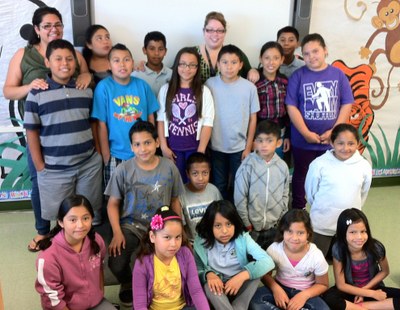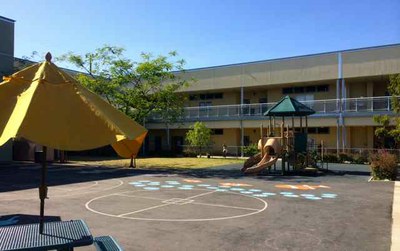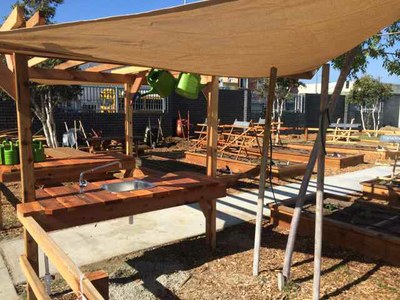Michelle Staine's Portfolio Homepage
Autobiographical Statement
A Life-Changing Moment
bell hooks, noted social activist and author, suggests that individuals can engage in feminist action without ever having heard the term; I believe the same can be said of my commitment to social justice, particularly in the field of education.
I was young – fresh out of high school – and working as a Teacher’s Assistant at my former middle school when I first became aware of social justice issues. Though I had no knowledge of Critical Race Theory, Critical Pedagogy, and related frameworks, I nonetheless worked to disrupt an oppressive power structure at my youngest sister’s elementary school.
She was a fifth grader, and culminating, when a mistake on her part almost cost her all of her social and academic privileges. She had been caught stealing stickers from one of the classrooms, and as a result, her teacher wanted to keep her from attending the class trip to Six Flags, and keep her from receiving an achievement award at her culmination ceremony.
Neither of my parents made it past middle school. My mother spoke no English, and my father was solidly blue collar. And so, when the time came, it was I, and not my parents that made a call to schedule a meeting with the principal and the teacher to discuss my sister’s situation.
I had become aware, thanks to my job, of the intricacies of navigating the district’s system, the language, the acronyms, the tone. Parents had rights, agency, my parents had rights, and I would give them access to agency.
 I took the time off to attend the meeting with my father and sister, and I’m very glad I did. At the meeting, the teacher presented her case, painting a picture of my sister as a “problem student” with a history of disciplinary issues. This was at the height of the district’s overcrowding, when the track system was in full swing, the principal had only vague notions of who my sister was, but his position and the teacher’s position as professionals and arbiters of power, cowed my father.
I took the time off to attend the meeting with my father and sister, and I’m very glad I did. At the meeting, the teacher presented her case, painting a picture of my sister as a “problem student” with a history of disciplinary issues. This was at the height of the district’s overcrowding, when the track system was in full swing, the principal had only vague notions of who my sister was, but his position and the teacher’s position as professionals and arbiters of power, cowed my father.
Because I had acquired the skills to dialogue with other district officials, I was able to counter that teacher’s narrative with my own. The teacher in question had in fact been out the majority of the year due to illness and had only taught my sister for a little over 5 weeks over the course of the academic year. The long-term substitutes had never had anything but lovely things to say about my sister, and she had never had any trouble at school prior to this incident.
In the end, my sister was able to participate in the culmination activities, spoke at her culmination, and received an award for her academic achievement. I may not have fully recognized the importance of that victory then, but after years of working inside and outside of the classroom, and after my time at the Principal’s Leadership Institute at the University of California, Los Angeles, I understand its significance in shaping the kind of teacher I became, and the kind of principal I hope to become.
My Journey as An Educator
I had always wanted to be an educator. Long after my peers abandoned make-believe games of “being teacher,” I continued to play the role with my sister filling in the role of pupil. Without knowing that I was developing my differentiating skills, I engaged my sister, then in fourth grade, in Total Physical Response (TPR) comprehension strategies while we both made our way through The Lord of the Flies.
I graduated from Los Angeles High School, and then took a Teacher’s Assistant job at Johnnie Cochran – formerly Mt. Vernon – Middle School, while attending community college. I worked steadily at my job, and at school, until finally earning my A.A. and working toward transferring to a four-year college.
I received my Bachelor’s from one of the premier undergraduate teacher preparation programs in California at Mt. St. Mary’s College. Mt. St. Mary’s prepared me exceedingly well to be an attentive and thorough teacher.
 Upon graduation, I embarked on a short-lived career as a middle school science teacher. I was again faced with the systematic short comings of the district: I was teaching science in overcrowded classrooms, which, to top it all off, were not even science classrooms. The story is an old one: there were not enough desks for students, books were scarce, and those that were available were old, damaged, and practically useless when coupled with a lack of Bunsen burners, beakers, and science equipment.
Upon graduation, I embarked on a short-lived career as a middle school science teacher. I was again faced with the systematic short comings of the district: I was teaching science in overcrowded classrooms, which, to top it all off, were not even science classrooms. The story is an old one: there were not enough desks for students, books were scarce, and those that were available were old, damaged, and practically useless when coupled with a lack of Bunsen burners, beakers, and science equipment.
I left, and began on the pathway that would lead me to feel so passionately about advocacy and agency in elementary schools. I began teaching at my former elementary school, working there for years before transferring to my most recent school site, Carson-Gore Academy, where I took my first steps outside of the classroom, working as an Instructional Coach, the Intervention Coordinator, and the Categorical Programs Advisor.
My experience as a coordinator made me think about the possibility of becoming a principal, and those wayward thoughts lead to a dream, and that dream lead to my becoming a Master of Education candidate at UCLA, which gave me access to be able to name the actions and feelings that stirred my soul: social justice education.
My work outside of the classroom made me think more clearly about the roles of parents, the roles of teachers as members of a school learning community, and the roles of principals as leaders of the same.
The students I serviced as an educator, like my sister, had needs outside of the academic arena that aren’t being met, and that may cause some trouble, but educators must meet those incidents and needs with authentic care, and not punitive and marginalizing consequences.
The parents I serviced as an educator, like my own parents, have value. They have rights, and significance, but must be taught how to navigate the world of education; they must be taught the language, and not just the language of dominance, but also the language of the education profession. They must be informed of their rights, and given the means to exercise their agency.
I have had thoughts and feelings validated and deepened through the study of law and education, race, and I have been given access to theorists whose body of work supports my goals of bringing equity and equality to public education.
 School Context
School Context
Carson-Gore Academy of Environmental Studies is a Title I elementary school in Educational Service Center West, which services students in grades Pre-K – 5. It opened in 2010 to alleviate overcrowding, and facilitate the district-wide move toward a traditional academic calendar. Once construction of the school was completed, several Charters and organizations, including LAUSD, fought to gain control of the site, before finally becoming a Public School Choice elementary school. As part of the Public School Choice initiatives, it was established that the school would have an environmental studies focus.
 Named for two noted environmentalists – Rachel Carson & Former Vice President Al Gore – the school became slightly notorious before even opening. Huffington Post, The Los Angeles Times, and several other news sources lost little time in calling attention to the irony of an environmental studies school being located on a contaminated site – during construction it was discovered that there were contaminants in the soil due to leakage from underground storage tanks. The district spent a significant amount of time and money to clean up the contamination, and ensure the safety of the school community.
Named for two noted environmentalists – Rachel Carson & Former Vice President Al Gore – the school became slightly notorious before even opening. Huffington Post, The Los Angeles Times, and several other news sources lost little time in calling attention to the irony of an environmental studies school being located on a contaminated site – during construction it was discovered that there were contaminants in the soil due to leakage from underground storage tanks. The district spent a significant amount of time and money to clean up the contamination, and ensure the safety of the school community.
The Public School Choice initiative stipulates that schools have a series of years to implement their school plan in stages. In the four years since the founding, Carson-Gore has been primarily focused on its status as a Program Improvement school, but it has recently invested in a school garden, which would serve as a basis for future environmentally responsible cultivation practices.
 During the 2012 – 2013 school year there were 651 students enrolled. Of those 651 students, 88% are Latino and 10% are African-American. The school also has a high population of economically disadvantaged students, 89%, and a high number of English Language Learners (ELLs), 53%.
During the 2012 – 2013 school year there were 651 students enrolled. Of those 651 students, 88% are Latino and 10% are African-American. The school also has a high population of economically disadvantaged students, 89%, and a high number of English Language Learners (ELLs), 53%.
Data shows that ELLs are a sub-population in need of targeted support at Carson-Gore: less than 30% of the eligible ELLs performed at a proficient or advanced level on the CSTs. However, 53% of those ELLs performed at a basic level or above – facilitating their opportunities to reclassify – though that number is below the district average, 62%.
In light of the needs of the students at Carson-Gore, the faculty, staff, and administration have worked collaboratively to holistically meet the needs of all learners: budget dialogues always focus on purchasing positions and staff to help student achievement, the school is being assigned a Title 3 coach, much care is taken to faithfully comply with master plan requirements, and the school is committed to conducting quarterly reviews to look for areas of improvement and develop action plans.
Projects
- Math Practices in Action PD Series and Promising Practices PLC
- Pathways to Common Core Planning, Elementary Mathematics
- Building Agency Through School Community Events
- Monitoring and Supporting English Learners
- Action Research Project: Reciprocal Peer Observations to Support Implementation of Universal Access Strategies

